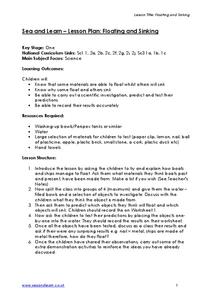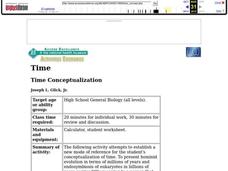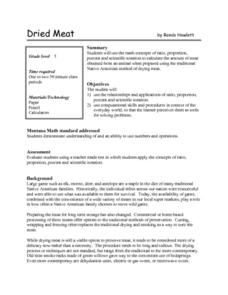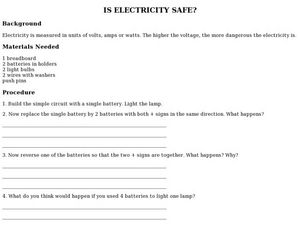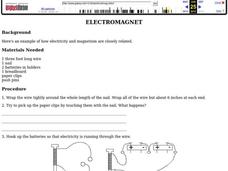Curated OER
Oobleck
Students examine states of matter. In this solids and liquids lesson, students conduct a scientific investigation that requires them to make oobleck and record their observations pertaining to it.
Curated OER
What Do Scientists Do?
Middle schoolers do a report on distinct scientific fields using the Internet resources provided. They see the connection between what they learn in the classroom and what goes on in the enterprise of science.
Curated OER
Floating and Sinking
Students conduct experiments in which they investigate which materials float and which sink. They examine what qualities the materials that float have in common. They carry out a scientific investigation, predict, and test their...
Curated OER
Naming New Species
Learners explore science of taxonomy and the Five Kingdoms of life,
categorize organisms into Kingdoms, and create multi-media presentations illustrating knowledge of a Kingdom. They collect data and related pictures on the Internet,...
Curated OER
Time Conceptualization
High schoolers use this activity to establish a new mode of reference to the conceptualization of time. To present hominid evolution in terms of millions of years and endosymbiosis of eukaryotes in billions of years carries little...
Curated OER
Dried Meat
Learners investigate the traditional method of drying meat used by Native Americans. They apply math concepts such as ratio, proportion, percent, and scientific notation to determine the amount of meat the is dried from an animal using...
Curated OER
Critter? Growth
Students identify and use the elements of the scientific inquiry to solve problems. They explain concepts about the structure and properties of matter. Pupils write an explanation of polymers and how the characteristic of polymers...
Curated OER
Experiences and Experiments - There is a Difference
Sixth graders plan and conduct an experiment on food spoilage. They design the experiment, create a display, record and analyze data, and make inferences regarding the results of the experiment.
Curated OER
Making Marbles
Learners perform a simulation in which they work for a toy company and have to figure out how many marbles of different sizes can be made with the provided material. They must design their own experiment to figure this out.
Curated OER
Temperature School
Pupils observ the cooling and warming of room temperature, hot, and ice cold cans of water by measuring the change in temperature over time. They then attempt to develop explanations for the observations made and apply their findings to...
Curated OER
Balls and Ramp
Students role several balls of different weights down a ramp and into a paper cup and record how far each ball made the paper cup move. They then answer questions that help them analyze their results and reinforce the idea that energy...
Curated OER
Plastic Wrap
Learners compare the price and quality of different kinds of plastic kitchen wraps and then rank them from best to worst. They take into account how well it comes out of the roll, if it seals well, it is tangles, how much weight it...
Curated OER
Every Breath You Take
Students study acids and bases and the uses of indicators. They interpret the actions of an indicator to conclude that bromothymol blue turns yellow in the presence of a weak acid.
Curated OER
Inquiring Minds
Young scholars demonstrate understanding of the scientific inquiry. They identify the major components of the scientific process.
Curated OER
Cody's Science Education Zone
Students observe a scientific experiment and pose a hypothesis. For this scientific inquiry lesson, students make predictions about the combination of alcohol in water and how it will affect a floating ice cube.
Curated OER
Student Designed Investigations Part 3 – Collecting Data and Drawing Conclusions
Learners explore how living things adapt to their environment. In this science lesson, students conduct scientific investigations to examine animal adaptations.
Curated OER
Defining the Difference Between Prokaryotic and Eukaryotic Cells
Students examine microscopic life by conducting a scientific investigation. In this cell analysis lesson, students define the prokaryotic and eukaryotic cells and discuss their word origins. Students view each type of cell on slides...
Curated OER
Pulleys 1
In this simple machines scientific investigation activity, students follow the provided procedures to examine how pulleys work and then respond to 2 short answer questions.
Curated OER
Inclined Plane 1
In this scientific investigation worksheet, students follow the provided procedures to create an inclined plane paper model and then respond to 1 short answer question.
Curated OER
Static Electricity
In this scientific investigation activity, students follow the provided procedures to examine static electricity and then respond to 1 short answer question.
Curated OER
Is Electricity Safe?
In this scientific investigation activity, learners follow the provided procedures to examine the safety of electricity and then respond to 3 short answer questions.
Curated OER
Magnetic Poles
In this scientific investigation worksheet, students follow the provided procedures to examine positive and negative charges of magnets and then respond to 3 short answer question.
Curated OER
Electromagnet
In this scientific investigation activity, learners follow the provided procedures to examine how electricity and magnetism are related and then respond to 4 short answer questions.
Curated OER
Seeing Is Believing: Atoms
In this scientific investigation worksheet, students follow the provided procedures to examine 4 mystery objects and then respond to 2 short answer questions.
Other popular searches
- Scientific Method Worksheet
- Scientific Method Activities
- Scientific Method Variables
- The Scientific Method
- Scientific Method Hypothesis
- Six Step Scientific Method
- Scientific Method Lab
- Scientific Method Powerpoint
- Basic Scientific Method
- Scientific Method Botany
- Scientific Method Lab Report
- Scientific Method Vocabulary




